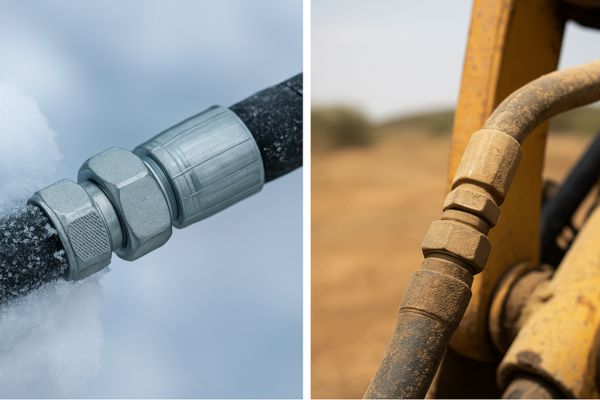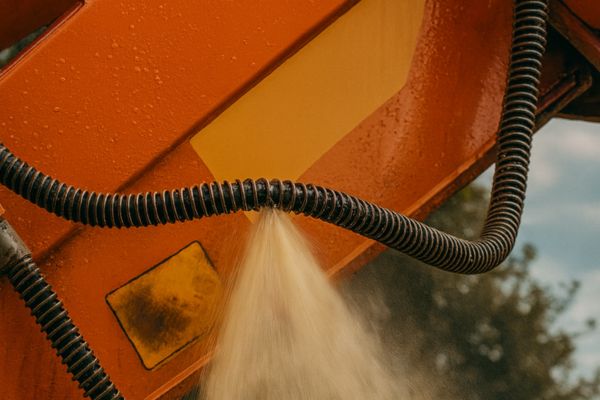Burst excavator’s hydraulic hoses are catastrophic event, causing costly downtime, environmental hazards, and serious safety risks. This guide dissects the 7 primary causes of hose failure, from system pressures to operator habits, and outlines the correct emergency response.
The Foundation of Failure: Substandard Hose Assemblies
Most hydraulic hose failures don’t happen in the field — they’re built in from the start.
Choosing cheap, uncertified hose assemblies may save money upfront but almost always leads to costly downtime, leaks, and safety hazards later.
In short, substandard assemblies are the number-one preventable cause of premature blowouts.

The Pitfalls of Inferior Materials
Low-cost hoses and fittings often compromise the two fundamentals of hose reliability: rubber quality and reinforcement strength.
| Component | Common Shortcut | Typical Failure Mode |
| Inner tube | Poor-quality rubber compounds | Swelling, softening, or cracking under heat and oil exposure |
| Reinforcement | Low-tensile steel wire or uneven braiding | Fatigue, wire breakage, and burst failure |
| Outer cover | Thin or non-oil-resistant rubber | Abrasion, weathering, or blister formation |
Key insight: A weaker wire braid or poor rubber formulation may pass initial inspection but will quickly fail under repeated pressure cycles.
Every pressure spike acts like a hammer — and inferior materials simply can’t take the hits.
The Criticality of the Crimp
The crimp is where theory meets reality — the precise connection between fitting and hose that determines whether the assembly will hold under pressure.
What defines a quality crimp:
- Calibrated equipment verified with digital micrometers
- Consistent crimp diameter within tolerance
- Uniform compression across all 360° of the ferrule
What cheap assemblies often show:
- Under-crimping: Too loose → fluid leaks or hose blow-offs
- Over-crimping: Too tight → cracked inner tube, damaged reinforcement, and reduced hose life
- Uneven crimping: Inconsistent pressure from worn dies → early failure during flex cycles
| Crimp Defect | Visible Symptom | Result |
| Loose ferrule | Hose pulls out under load | Blow-off / major leak |
| Crushed reinforcement | Flat spots, kinked end | Weak burst strength |
| Uneven crimp | Ferrule tilted or twisted | Localized stress, early failure |
Pro tip: Always request the manufacturer’s crimp specification sheet — if they can’t provide one, that’s your first red flag.
Why OEM or Reputable Brands Matter
Certified hose assemblies from OEMs or trusted aftermarket brands are engineered, tested, and traceable.
They’re designed to match the equipment’s flow rate, pressure rating, and operating environment — not just “fit” the port.
Advantages of using certified assemblies:
- Guaranteed compliance with SAE, EN, or ISO standards
- Verified crimp parameters and material certifications
- Batch traceability for warranty and quality assurance
- Reliable replacement compatibility across product lines
| Supplier Type | Quality Control | Traceability | Expected Service Life |
| OEM / Reputable brand | Fully tested and certified | Batch-number traceable | Long and predictable |
| Generic supplier | Unverified processes | No tracking system | Short and inconsistent |
Bottom line: The cheapest hose is never the most affordable in the long run. The right assembly ensures reliability, protects operators, and reduces unplanned downtime.
System Overload: When the Machine Fights Itself
Not every hose failure is the hose’s fault.
Sometimes, it’s the hydraulic system itself — running beyond its design limits — that destroys even the best assemblies.
Excessive pressure and heat are the silent killers of hydraulic components, and the hose is often the first to pay the price.
Excessive System Pressure
When a hydraulic system operates above its rated pressure, the effects ripple through every component. The hose, being the most flexible part, absorbs the shock — and fails first.
| Issue | Cause | Effect |
| Relief valve set too high | Incorrect calibration or bypass tampering | Continuous over-pressure on hoses |
| Pressure spikes from abrupt valve operation | Sudden flow stops or cylinder bottoming out | Localized hose fatigue and micro-tears |
| Faulty or stuck relief valve | Contamination or spring failure | Uncontrolled pressure buildup |
Result: Over time, this leads to reinforcement wire fatigue, inner tube separation, and eventual rupture.
Best Practice:
- Have a qualified technician test and calibrate relief valves using certified gauges.
- Always maintain pressures within the manufacturer’s rated limits.
- Monitor and log system pressure periodically, especially after maintenance or retrofitting.

The Heat Factor — High Oil Temperature
Hydraulic oil temperature is just as dangerous as pressure.
Once operating temperatures exceed 82°C (180°F), the damage begins silently.
What happens above 82°C:
- Rubber compounds harden and lose elasticity.
- Inner tube adhesion weakens, leading to blistering and cracks.
- O-rings and seals shrink or deform, causing leaks.
- The oil itself oxidizes, forming varnish that clogs valves and filters.
| Temperature Range | Hose Behavior | System Impact |
| 60–80°C (140–176°F) | Safe working range | Stable performance |
| 82–100°C (180–212°F) | Accelerated aging | Hardening of rubber and seal degradation |
| >100°C (212°F) | Rapid breakdown | Hose and seal failure, oil carbonization |
Tip: Install a temperature gauge or digital sensor on the return line to detect rising oil temperatures before failure occurs.
The Vicious Cycle of Heat
High heat doesn’t just damage hoses — it damages the entire system’s ability to cool itself, creating a destructive feedback loop.
How it happens:
- Hot oil causes valve components to expand and stick, producing erratic pressure spikes.
- Pressure spikes generate even more frictional heat.
- The radiator or oil cooler becomes clogged with dirt or debris, further trapping heat.
- The system runs hotter and hotter — until a hose bursts or the pump seizes.
Prevention Checklist:
- Inspect and clean the oil cooler or radiator regularly.
- Check for restricted return lines or clogged filters.
- Replace fluid that smells burnt or appears dark and thick.
- Keep reservoir levels correct — low oil amplifies heat buildup.
The Human Element: Destructive Operating Habits
A skilled operator can significantly extend a machine’s life, while rough handling can destroy it. Abrupt and aggressive operation creates violent hydraulic shockwaves that are far more damaging to hoses than simple static pressure.
The Impact of Hydraulic Shock
Every time a joystick is slammed or a cylinder bottoms out at full speed, a massive pressure spike is generated. This “water hammer” effect fatigues the hose’s wire reinforcement and stresses the crimped fittings, leading to premature failure right at the connection point.
The True Cost of Rough Operation
Beyond hoses, aggressive operation accelerates wear on pins, bushings, and structural components, leading to more frequent and costly mechanical failures. Smooth, controlled movements are the hallmark of a professional operator and are essential for machine longevity.
Finesse Over Force
The goal is to operate with precision and finesse. Gently feathering the controls to start and stop movements minimizes pressure spikes. This not only saves the hoses but also improves fuel efficiency and reduces overall stress on the entire machine.
| Destructive Action | Hydraulic Consequence | Resulting Hose Damage | Corrective Action |
| Slamming Joysticks | Creates instantaneous pressure spikes throughout the system. | Rapid fatigue of wire reinforcement; potential for fitting blow-off; internal hose layer damage. | Feather the controls; aim for smooth acceleration and deceleration of functions. |
| Hard Bucket Impact | Generates extreme shock loading when the cylinder bottoms out or hits an object. | Weakens the crimp connection at cylinder port fittings; can cause hose rupture near the impact point. | Control the final inches of cylinder travel; avoid using the bucket as a hammer. |
| Rapid Direction Changes | Causes multiple pressure spikes as relief valves cycle hard. | Accelerates fatigue in all working lines; stresses motor and pump connections. | Pause for a split-second between movement reversals to allow pressure to stabilize. |
Chemical & Environmental Assault
The battle for hose survival is also waged against external threats. Chemical exposure, contamination, and constant vibration can degrade a hose from the outside in, silently weakening it until it can no longer contain the pressure within.
The Threat of Chemical Corrosion
While hoses are oil-resistant, they are not immune to all chemicals. Prolonged exposure to diesel fuel, solvents, or other aggressive fluids can cause the outer cover to swell, soften, and deteriorate. This exposes the reinforcement wire to the elements, leading to rust and failure.
Vibration: The High-Frequency Killer
Pumps generate natural pressure pulsations that create high-frequency vibrations. If a hose is not properly secured with clamps, this vibration can cause it to chafe against the machine’s frame or other components, wearing away the cover and eventually sawing through the reinforcement.
The Danger of Mixing Hydraulic Fluids
Using the wrong type of hydraulic fluid or mixing different types (e.g., adding standard ISO 68 to an ISO 46 system) can be disastrous. It alters the fluid’s viscosity, causing higher pressures and temperatures, and can lead to chemical reactions that degrade seals and hose inner tubes.
Emergency Protocol: Responding to a Hose Failure
When a hose bursts, your immediate actions can dramatically minimize the financial, environmental, and safety impact. A calm, methodical response is essential to securing the machine and preventing further loss or injury.
Immediate Action: Secure the Machine
The instant you hear or see a hose burst, your first priority is to stop the machine and safely lower all implements (bucket, stick, boom) to the ground. This releases the stored energy in the hydraulic system and reduces the pressure, slowing the leak.

Shut Down and Depressurize
Once the implements are grounded, immediately shut down the engine. This stops the hydraulic pump from feeding more oil to the rupture. You may also need to cycle the controls with the engine off to release any trapped pressure in the accumulators or circuits.
The Reality of Field Repairs
WARNING: A temporary “patch” on a high-pressure hose is extremely dangerous and not a recommended practice. The methods described in some forums (glue, tape, etc.) are only a last-ditch effort for very low-pressure lines and are unreliable. Swapping a low-pressure hose (e.g., return line) with a burst high-pressure line is also dangerous, as that hose is not rated for the pressure.
| Emergency Step | Action | Reasoning |
| 1. Stop Movement | Immediately cease all machine operations and movement. | Prevents unpredictable machine behavior and minimizes oil loss under high flow. |
| 2. Ground Implements | Lower the bucket, boom, blade, and any other attachments to the ground. | Safely releases stored hydraulic energy and pressure from the cylinders. This is the most critical step. |
| 3. Shut Down Engine | Turn the engine off completely. | Stops the hydraulic pump, which is the source of the pressure and flow. |
| 4. Depressurize System | With the engine off, move the controls back and forth several times. | Relieves any trapped pressure in the circuits between the valves and actuators. |
| 5. Assess & Contain | Identify the location of the burst and use an oil spill kit to contain the leak. | Prevents environmental contamination and makes the repair area safer. |
| 6. Call for Service | Contact a qualified technician to perform a proper replacement of the hose assembly. | Ensures the correct, certified replacement hose is installed safely and correctly. |
The Best Fix: Prevention and Proactive Maintenance
The most effective way to deal with a burst hose is to prevent it from ever happening. A culture of proactive maintenance, diligent inspection, and operator awareness is the key to maximizing reliability and safety.
The Daily Walk-Around Inspection
Before starting work each day, conduct a thorough visual inspection. Look for signs of hose cover abrasion, cracking, blistering, or weeping at the fittings. Pay special attention to hoses that articulate and flex, as they are subjected to the most stress.
Keep It Clean
A clean machine is easier to inspect. Regularly power washing mud and grease off the machine allows you to spot small leaks before they become catastrophic failures. A clean hose is also less likely to be damaged by abrasive debris trapped against it.
Heed the Warning Signs
A hydraulic system will often give you warnings before a major failure. Sluggish or jerky operation, unusual noises, or a consistent rise in operating temperature are all signs that something is wrong. Investigate these symptoms immediately.
FAQ
Is a temporary patch on a high-pressure hose ever safe?
No. There is no safe, reliable way to patch a hose rated for modern excavator pressures (3,000+ PSI). The pressure and flow will blow through any temporary fix, creating an extreme danger. The only correct and safe solution is complete replacement of the assembly.
Why can’t I just replace the hose with a cheaper one from an auto parts store?
Automotive hoses (e.g., fuel lines or brake lines) are not designed for the extreme pressures and pressure impulses of a hydraulic system. Using one is a guarantee of immediate and catastrophic failure. Always use a hose that meets or exceeds the machine’s OEM pressure rating.
What is the most common sign that a hose is about to fail?
The most common visual signs are weeping or leaking fluid right at the fitting crimp, and cracks or deep abrasion marks on the outer cover. A blister or “bubble” on the cover is a critical sign of internal failure, and the hose should be replaced immediately.
How does cold weather affect my hydraulic hoses?
Extremely cold temperatures can cause the hose rubber to become stiff and less flexible. This makes them more susceptible to cracking if flexed before the system has had a chance to warm up. Always allow the machine a proper warm-up period in cold weather.
I see oil on a hose, but it’s not dripping. Can I still run the machine?
This is known as “weeping” or “seeping.” While not an immediate emergency like a burst, it is a clear sign that the hose assembly is failing. It should be scheduled for replacement as soon as possible, as it will eventually become a major leak.
Should I tighten a fitting that is weeping oil?
It is generally not a good idea. The leak is often caused by a failing seal or a compromised crimp, not a loose nut. Overtightening a fitting can damage the threads or crush the seal, making the leak much worse. The correct procedure is to replace the assembly.





